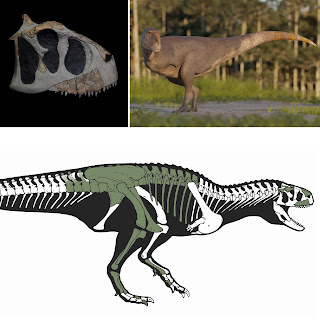Abstract
Gondwanan dinosaur faunae during the 20 Myr preceding the Cretaceous–Palaeogene (K/Pg) extinction included several lineages that were absent or poorly represented in Laurasian landmasses. Among these, the South American fossil record contains diverse abelisaurids, arguably the most successful groups of carnivorous dinosaurs from Gondwana in the Cretaceous, reaching their highest diversity towards the end of this period. Here we describe Koleken inakayali gen. et sp. n., a new abelisaurid from the La Colonia Formation (Maastrichtian, Upper Cretaceous) of Patagonia. Koleken inakayali is known from several skull bones, an almost complete dorsal series, complete sacrum, several caudal vertebrae, pelvic girdle and almost complete hind limbs. The new abelisaurid shows a unique set of features in the skull and several anatomical differences from Carnotaurus sastrei (the only other abelisaurid known from the La Colonia Formation). Koleken inakayali is retrieved as a brachyrostran abelisaurid, clustered with other South American abelisaurids from the latest Cretaceous (Campanian–Maastrichtian), such as Aucasaurus, Niebla and Carnotaurus. Leveraging our phylogeny estimates, we explore rates of morphological evolution across ceratosaurian lineages, finding them to be particularly high for elaphrosaurine noasaurids and around the base of Abelisauridae, before the Early Cretaceous radiation of the latter clade. The Noasauridae and their sister clade show contrasting patterns of morphological evolution, with noasaurids undergoing an early phase of accelerated evolution of the axial and hind limb skeleton in the Jurassic, and the abelisaurids exhibiting sustained high rates of cranial evolution during the Early Cretaceous. These results provide much needed context for the evolutionary dynamics of ceratosaurian theropods, contributing to broader understanding of macroevolutionary patterns across dinosaurs.
DINOSAURIA Owen, 1842.
THEROPODA Marsh, 1881.
CERATOSAURIA Marsh, 1884.
ABELISAURIDAE Bonaparte and Novas, 1985
BRACHYROSTRA Canale et al., 2009
FURILEUSAURIA Filippi et al., 2016
Koleken gen. n.
Derivation of name: Adapted from Kóleken, a name in Teushen language spoken by the native population of central Patagonia that means “coming from clay and water”, given the specimen was found in a sedimentary section dominated by claystone representing an estuarine environment.
Koleken inakayali gen. et sp. n.
Derivation of name: Honouring Inakayal, one of the last chiefs of Tehuelches, native people from central Patagonia. He is known for his resistance against Argentina's Conquest of the Desert military campaign, which resulted in the decimation and displacement of native communities from Patagonia. After his capture and eventual death in 1888, Inakayal's skeleton was stored at the La Plata Museum Anthropology collection but in 1994 his skeleton was respectfully restituted in its native place and buried by his people near the town of Tecka, in central Patagonia (Chubut Province, Argentina).
Holotype: MPEF-PV 10826. The specimen includes closely associated (but disarticulated) remains of the skull and atlas, as well as the articulated postcranial skeleton composed of the posteriormost eight dorsal vertebrae, a complete sacrum, eight caudal vertebrae, an almost complete pelvis and hind limbs. Select measurements are provided in Table S1.
Locality and horizon: The specimen was found at the Cerro Bayo Norte area, east of the Sierra de La Colonia, centre north of Chubut Province, Argentina (Fig. 1). Precise geographical provenance is deposited at the MPEF collection. The specimen was found close to the base of the stratigraphic section of the La Colonia Formation that crops out in this region (see Gasparini et al., 2015: Fig. 2). The age of the base of this unit has been recently restricted to the early Maastrichtian (Clyde et al., 2021), constraining the age of the new taxon to the Maastrichtian.
Diagnosis: Koleken inakayali is a brachyrostran abelisaurid different from other theropods in having the following set of autapomorphies (marked with a *): (i) medially smooth paradental plates; (ii) dorsal surface of the nasal with a row of foramina orientated obliquely with respect to the longitudinal skull axis; (iii) *anterior ramus of the postorbital lacking the lateral wall reflected by a dorsoventral height less than half of its anteroposterior length, which makes the orbital surface face ventrally instead ventromedially; (iv) *dorsal surface of the postorbital with a ...
Diego Pol, Mattia Antonio Baiano, David Černý, Fernando E. Novas, Ignacio A. Cerda and Michael Pittman. 2024. A New abelisaurid Dinosaur from the end Cretaceous of Patagonia and Evolutionary Rates among the Ceratosauria. Cladistics. DOI: 10.1111/cla.12583









